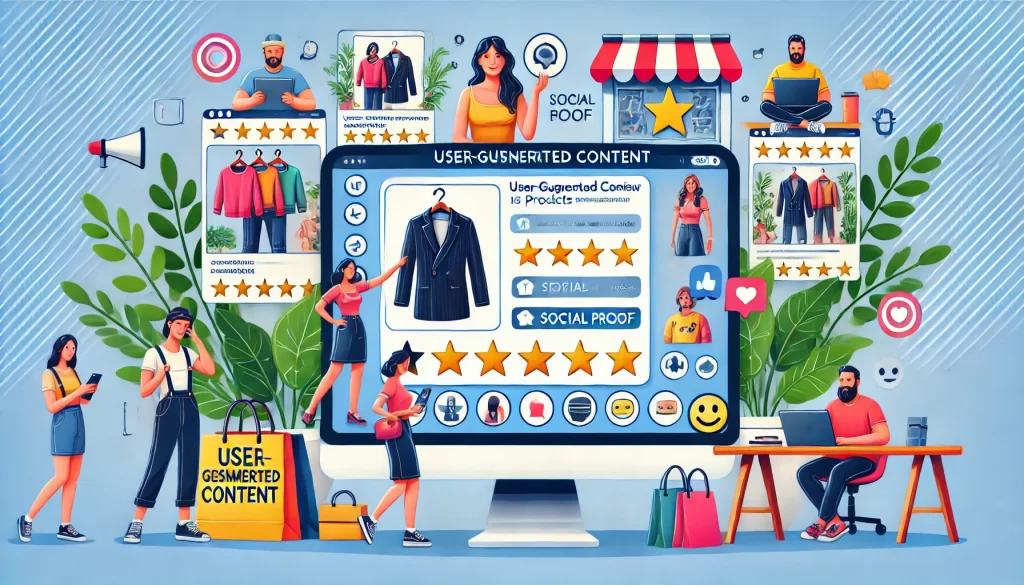In today’s fast-paced, mobile-first world, optimizing your e-commerce website for mobile shoppers is no longer a luxury—it’s a necessity. With more than 50% of all web traffic coming from mobile devices, the importance of having a responsive and mobile-friendly e-commerce site cannot be overstated.
Mobile optimization ensures that your website delivers an excellent user experience on smartphones and tablets. It involves everything from responsive design to fast-loading pages and easy navigation. A site that’s optimized for mobile not only provides a better shopping experience but also improves your conversion rates, SEO rankings, and customer satisfaction.

Impact of Mobile Shopping on E-commerce:
- Over 70% of e-commerce traffic comes from mobile devices.
- Mobile sales now account for more than 50% of global e-commerce revenue.
- Mobile shoppers expect fast, seamless, and user-friendly experiences.
Key Strategies to Optimize Your E-commerce Website for Mobile Shoppers
1. Implement a Mobile-Responsive Design
A mobile-responsive design automatically adjusts the layout of your website to fit the screen size of any device, whether it’s a smartphone, tablet, or desktop. The key here is fluid design, which means that your content, images, and other elements flow smoothly to fit the screen.
Related Posts
- Technical SEO Audits
- How Often Should You Do an SEO Audit?
- Leverage Social Proof for Ecommerce Conversions
Why It Matters:
- Improves user experience (UX): Visitors can easily navigate your site without constantly zooming in or out.
- Boosts SEO rankings: Google prioritizes mobile-friendly websites in its search results.
- Increases conversion rates: A well-designed mobile site encourages users to stay longer and complete purchases.
Tips for a Mobile-Responsive Design:
- Simplify the layout: Avoid clutter. Ensure that your mobile design is clean and easy to navigate.
- Test across devices: Regularly test your website on various screen sizes to ensure it looks good on all devices.
- Make buttons and links large enough to tap: Touchscreen devices need clickable elements that are easy to tap.
2. Improve Page Load Speed
A slow-loading website is one of the biggest deterrents for mobile shoppers. Mobile users have limited patience when it comes to waiting for pages to load. Research shows that 53% of mobile visitors will leave a page if it takes longer than 3 seconds to load.
Why It Matters:
- Reduces bounce rates: Fast-loading pages keep users engaged.
- Improves mobile conversions: Shoppers are more likely to complete purchases if the website loads quickly.
- Boosts SEO: Page speed is a ranking factor for Google, and faster sites tend to rank higher.
Tips for Speed Optimization:
- Optimize images: Compress and resize images without sacrificing quality.
- Minimize redirects: Each redirect can slow down your website. Keep them to a minimum.
- Use content delivery networks (CDNs): CDNs store copies of your site on servers around the world, ensuring faster load times for mobile users.
3. Simplify Navigation and Checkout Process
Mobile screens are smaller, which means that your navigation needs to be simple, intuitive, and easy to use. When designing your mobile site, keep the checkout process short and straightforward to reduce friction and abandoned carts.
Related Posts
Why It Matters:
- Streamlined navigation improves the shopping experience and reduces frustration.
- A simplified checkout process leads to fewer abandoned carts, increasing conversions.
Tips for Optimizing Navigation and Checkout:
- Use a sticky header for navigation: Make it easy for users to navigate between product categories and pages, even as they scroll.
- Limit form fields: Ask for only the essentials during checkout, and consider using auto-fill for faster checkouts.
- Implement a one-click checkout option: Allow returning customers to check out with a single tap or click.
4. Optimize Product Images and Descriptions
Mobile shoppers rely heavily on visual content, so ensuring your product images and descriptions are high quality and optimized for mobile is crucial. Users expect to see clear, sharp images, and detailed descriptions without having to zoom in excessively.
Why It Matters:
- Visual appeal is important for mobile shoppers, as they can’t touch or feel the product.
- Clear, detailed product information reduces uncertainty and increases trust, leading to more sales.
Tips for Optimizing Product Pages:
- Use high-quality, zoomable images: Let users zoom in to see product details.
- Write concise yet informative descriptions: Include key features and benefits, but keep them easy to read on smaller screens.
- Include videos or 360-degree views: If possible, showcase your product with a video or interactive image.
5. Ensure Easy Mobile Payments
For mobile shoppers, an easy and secure payment process is paramount. Long, complicated checkout processes are the primary cause of cart abandonment on mobile. To increase conversions, you need to make it as easy as possible for users to complete their purchases.
Why It Matters:
- Simplifies the purchasing process: Mobile-friendly payment options speed up the transaction.
- Increases trust: Secure payment options give shoppers confidence in your website’s security.
Tips for Mobile Payment Optimization:
- Offer mobile-friendly payment options: Include options like Apple Pay, Google Pay, and PayPal.
- Enable guest checkout: Let users purchase without creating an account.
- Highlight security badges: Display trust signals, like SSL certificates, to assure customers that their payment details are safe.
6. Implement Mobile-Specific Features
There are specific features you can implement on your mobile site to enhance the shopping experience for mobile users. These features are designed to work best on smartphones and tablets, offering additional convenience to users on the go.
Why It Matters:
- Mobile-specific features make it easier for customers to shop on their phones, improving the overall user experience.
- Mobile features can increase conversions by providing added convenience for shoppers.
Mobile-Specific Features to Consider:
- Push notifications: Notify users about sales, discounts, or cart reminders through push notifications.
- Location-based offers: Use geolocation to offer personalized promotions when users are near your store.
- Voice search: With the rise of voice assistants like Siri and Google Assistant, voice search is becoming an increasingly important feature.

How Mobile Optimization Affects Your E-commerce Business
Improved SEO Rankings
Mobile optimization is not only about user experience; it also affects your SEO rankings. Google’s mobile-first indexing means that the mobile version of your website is now the primary version for ranking purposes. Websites that are mobile-friendly will have a significant advantage in search results.
Increased Conversion Rates
Optimizing your website for mobile shoppers directly impacts your conversion rates. When visitors have a seamless and enjoyable experience, they are much more likely to make a purchase. Studies show that mobile-friendly websites have a 30% higher conversion rate than those that aren’t optimized.
Enhanced Customer Experience
Mobile optimization enhances the overall customer experience. By offering fast load times, easy navigation, and a smooth checkout process, you’ll create a positive impression that can lead to repeat customers and brand loyalty.
Frequently Asked Questions (FAQs)
What is mobile optimization for e-commerce?
Mobile optimization involves making your e-commerce website user-friendly and responsive on mobile devices, ensuring a smooth experience for mobile shoppers.
Why is mobile optimization important for my e-commerce site?
Mobile optimization improves user experience, reduces bounce rates, and increases conversion rates, all of which directly impact your business success.
How can I make my e-commerce website mobile-friendly?
Implement a responsive design, optimize page load speed, simplify navigation, and ensure that checkout is quick and easy for mobile users.
What is the impact of slow page speed on mobile conversion rates?
Slow load times can increase bounce rates and decrease conversions. Mobile users expect pages to load in under 3 seconds—anything slower can hurt your business.
Can mobile optimization help improve my SEO rankings?
Yes! Google prioritizes mobile-friendly websites in search results, meaning mobile optimization can help improve your rankings and drive more organic traffic.
Key Takeaways
Mobile Optimization is Key to E-commerce Success
Mobile optimization is no longer optional—it’s essential for the success of your e-commerce business. With more customers shopping on mobile devices, ensuring a seamless and enjoyable experience for mobile shoppers will help you improve conversions, boost sales, and gain a competitive edge. Implement the strategies outlined here, and watch your mobile e-commerce store thrive.
